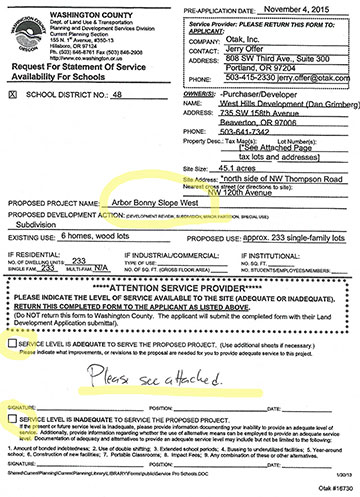 |
Previous Issues |
| Cedar Mill Community Website |
|
Search the Cedar Mill News: |
About The Cedar Mill News |
|
|||||||
| Volume 14, Issue 11 | November 2016 |
||||||
School district lets county decide on development’s impact on schools
|
|||||
 |
| Trees have been cleared and preliminary grading is underway at Arbor's Bonny Slope West development. Ward Creek lies below. |
In this issue we look at the impact of the additional students on the area schools: Bonny Slope Elementary, Cedar Park Middle School and Sunset High School. We will also look at the process whereby the Beaverton School District (BSD) weighs in on developments, and the hand the district has in shaping not only area schools, but housing growth in the part of Washington County it serves.
When the Washington County Department of Land Use and Planning approves a development, a hearings officer must address three main factors:
Critical services: water, sewer, drainage, fire protection and access to neighborhood roads;
Essential services: schools, access to highways and regional trails, police protection, street lighting, on-site pedestrian and bicycle facilities in the public right of way; and
Desirable services: public transportation service, traffic calming (slowing) devices, other community trails, pedestrian connectivity areas and off-site pedestrian and bicycle facilities.
Notice that schools are considered “essential,” not “critical” services. Of course, that doesn’t mean BSD doesn’t have a say in a development. It does. In the hierarchy of development applications, schools rank near the top after traffic and density impacts.
It’s apparent then, that the district’s voice is vital to the hearing officer’s decision. But BSD didn’t express itself clearly on this development. In fact, BSD likewise didn’t indicate one way or the other whether a 54-lot subdivision approved in April 2015, for 201 apartments at Kaiser Road and NW Brugger Road, would overcrowd schools. It’s a simple process: check one of two boxes that says “service level is adequate” or “service level is inadequate” on the official service provider letter (SPL) that the district submits on development applications.
Instead of taking a stand, BSD attached a letter pointing out that the affected schools “will likely be at or above capacity when these projects are completed.” Elementary and high schools’ capacity would be sufficient by 2017 and middle schools by 2020, it wrote. Until then the district said it would “continuously monitor enrollment and capacity at all schools and may, from time to time take additional actions to manage capacity related issues.”
 |
Though BSD didn’t say so, hearings officer Joe Turner speculated in his approval for the project that those additional actions would be boundary adjustments. BSD, which has just begun the process for creating the boundary for the new Kaiser Road K-5 in North Bethany, has no plans to adjust any other elementary boundaries, said Robert McCracken, district facilities planning manager.
Turner also pointed out that state law requires the district to accommodate students who will live in the new houses. But BSD doesn’t gauge capacity based on local schools’ space for children, but on the entire Beaverton School District. So, while logic says the new residents would go to Findley Elementary, the closest school, that’s not where BSD wants to send them. Instead they’ll be assigned to Bonny Slope Elementary, a bus ride away. And middle schoolers will go to Cedar Park, not Stoller Middle School, the closest option.
As it happens Turner was also the hearings officer for the Kaiser/Brugger Roads development. He took the district to task for the lack of box-checking on that development too, calling it “unfortunate as it created some uncertainty in this case.” Residents and the CPO 7, which is the official voice of the area’s residents, came out against the Kaiser/Brugger development on the capacity issue, also finding fault with BSD’s unwillingness to state its point of view, referring to “vague statements” in the district’s SPL.
In granting approval to that development, Turner remarked “the school district and the county should be discussing options to address the school capacity concerns in this area. However, the hearings officer has no authority to require such a discussion as a condition of approval.”
School capacity was touched on in the Thompson Woods development, along with negative impacts from construction traffic, destruction of trees and wildlife habitat, the planned trail, and adequate notice for the public hearing. Only nine people spoke against the development at the May hearing.
Ongoing residential development in Washington County is a given. With the popularity of the state and Metro area and the county’s long term planning goals, housing will replace farm and forest land within the Urban Growth Boundary. The question is, how will it be done. And how much say do current residents (and their school-age children) have. How will laws be applied that benefit one group or negatively impact others?
“I have always looked as land use as a type of game—with rules provided by the state and the county,” said Mary Manseau, Washington County Planning Commission member and Bethany resident, whose two children grew up in BSD. “Decisions are not based upon what is right for the community, but rather on whatever the rules allow. He who knows the rules best often is the winner of the game.
“Although we have tried to help BSD understand the rules, BSD feels like they are providing enough information to the county that the county is choosing to approve the applications.”
Because the school district won’t check the box regarding school capacity, Washington County has no recourse but approve these development applications. “Little can be done by the community, if the school district is unwilling to learn the rules of land use,” she said.
![]()
Like us on Facebook for timely updates
Published monthly by Pioneer Marketing & Design
Publisher/Editor:Virginia Bruce
info@cedarmillnews.com
PO Box 91061
Portland, Oregon 97291
© 2016